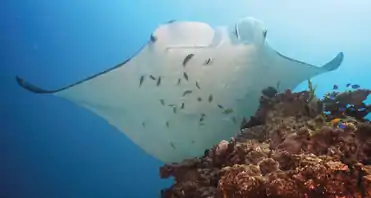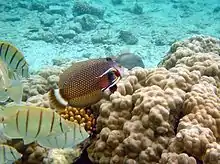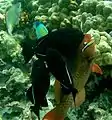Cleaning station
A cleaning station is a location where aquatic life congregate to be cleaned by smaller creatures. Such stations exist in both freshwater and marine environments, and are used by animals including fish, sea turtles and hippos, referred to as clients.[1]


The cleaning process includes the removal of parasites from the animal's body (both externally and internally), and is performed by various smaller animals including cleaner shrimp and numerous species of cleaner fish, especially wrasses and gobies (Elacatinus spp.), collectively referred to as cleaners.
When the animal approaches a cleaning station, it will open its mouth wide or position its body in such a way as to signal that it needs to be cleaned. The cleaner fish will then remove and eat the parasites from the skin, even swimming into the mouth and gills of any fish being cleaned. This is a form of cleaning symbiosis. How predator clients recognize cleaners is still uncertain. It has been hypothesized that color, size, and pattern indicate to clients that an organism is a cleaner.[2] For example, cleaning gobies tend to exhibit full-body lateral stripes, unlike their non-cleaning counterparts, which exhibit shorter lateral stripes.[2] Cleaners also tend to be smaller because in fish species, usually juveniles are cleaners.[2]
Cleaning stations may be associated with coral reefs, located either on top of a coral head or in a slot between two outcroppings. Other cleaning stations may be located under large clumps of floating seaweed or at an accepted point in a river or lagoon. Cleaning stations are an exhibition of mutualism between cleaners and clients.
Cleaner fish may also impact species diversity around coral reefs. Some clients have smaller home ranges and can only access one cleaning station. Clients with larger home ranges are able to access a variety of cleaning stations and are capable of choosing between cleaning stations.[3] Visitor clients travel long distances to a cleaning station and are not local to the ecosystem. This suggests that cleaners attract visitors to the local cleaning station ecosystem and thereby, affect species distribution in the local community.[4]
Some species of combtooth blenny, most notably the false cleanerfish, mimic the appearance and behaviour of cleaners, then tear away scales or flesh when suitably close to the victim. This behavior is referred to as cheating. If a client fish has been cheated previously at a station, it is unlikely to return to the station. Otherwise, when a client fish has undergone cleaning at a cleaning station without incident, it will likely return to the station for subsequent cleanings.[3]
Gallery
.jpg.webp) Stenopus hispidus banded cleaner shrimp on a Xestospongia muta barrel sponge: The shrimp wait to remove external parasites and dead skin from visiting fish clients.
Stenopus hispidus banded cleaner shrimp on a Xestospongia muta barrel sponge: The shrimp wait to remove external parasites and dead skin from visiting fish clients. A parrotfish being cleaned by Hawaiian cleaner wrasses, Labroides phthirophagus (photographed in 2005 in Hawaii)
A parrotfish being cleaned by Hawaiian cleaner wrasses, Labroides phthirophagus (photographed in 2005 in Hawaii) A needlefish being cleaned by L. phthirophagus
A needlefish being cleaned by L. phthirophagus A Hawaiian cleaner wrasse inside the gill of a pufferfish
A Hawaiian cleaner wrasse inside the gill of a pufferfish An orangespine unicornfish being cleaned by a Hawaiian cleaner wrasse
An orangespine unicornfish being cleaned by a Hawaiian cleaner wrasse A rockmover wrasse gets cleaned by a Hawaiian cleaner wrasse while an orangespine unicornfish waits its turn
A rockmover wrasse gets cleaned by a Hawaiian cleaner wrasse while an orangespine unicornfish waits its turn A goatfish, Mulloidichthys flavolineatus, at Kona, Hawaii, being cleaned by two Hawaiian cleaner wrasses
A goatfish, Mulloidichthys flavolineatus, at Kona, Hawaii, being cleaned by two Hawaiian cleaner wrasses
See also
References
- Hroch, Tomas. "Mzima Springs - Haunt of the hippo". eng.hrosi.org. Archived from the original on 12 November 2013. Retrieved 27 July 2014.
- Stummer, Laura; Weller, Jennifer; Johnson, Magnus; Cote, Isabelle (2004). "Size and stripes: how fish clients recognize cleaners". Animal Behaviour. 68: 145–150. doi:10.1016/j.anbehav.2003.10.018. S2CID 53299983. Retrieved 10 October 2022.
- Bshary, Redouan; Schaffer, Daniel (2002). "Choosy reef fish select cleaner fish that provide high-quality service". Animal Behaviour. 63 (3): 557–564. doi:10.1006/anbe.2001.1923. S2CID 53152241. Retrieved 10 October 2022.
- Grutter, Alexandra; Murphy, Jan; Choat, J (2003). "Cleaner Fish Drives Local Fish Diversity on Coral Reefs". Current Biology. 13 (1): 64–67. doi:10.1016/s0960-9822(02)01393-3. PMID 12526747. S2CID 15670411. Retrieved 10 October 2022.
- McGregor, Peter (2005). Animal Communication Networks. Cambridge University Press. ISBN 9780521823616.
- Ryan, Frank (2002). Darwin's Blind Spot: Evolution Beyond Natural Selection. Houghton Mifflin Harcourt. ISBN 0618118128.
- Hammerstein, Peter (2003). Genetic and Cultural Evolution of Cooperation. MIT Press. ISBN 978-0262083263.
- Bauer, Raymond T. (2004). Remarkable Shrimps: Adaptations and Natural History of the Carideans. University of Oklahoma Press. ISBN 978-0806135557.